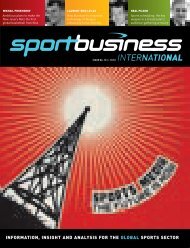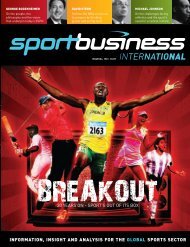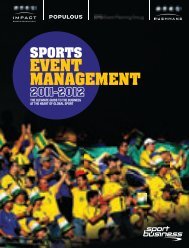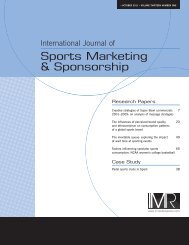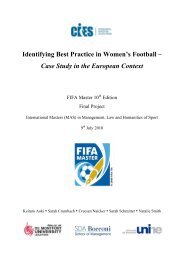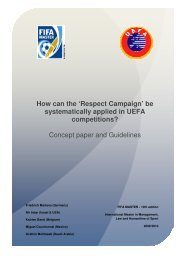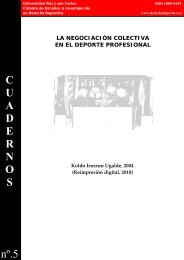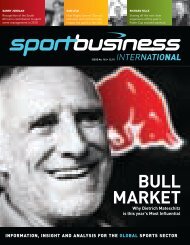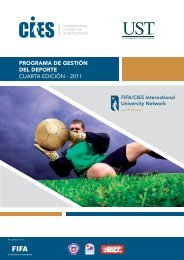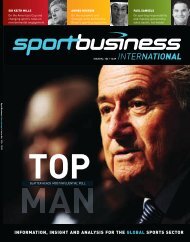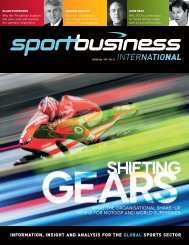Sports Marketing & Sponsorship - FIFA/CIES International University ...
Sports Marketing & Sponsorship - FIFA/CIES International University ...
Sports Marketing & Sponsorship - FIFA/CIES International University ...
- No tags were found...
Create successful ePaper yourself
Turn your PDF publications into a flip-book with our unique Google optimized e-Paper software.
Team attributes, identification and sponsor imageRESEARCH PAPERimage becomes apparent. Further support is offered byGrohs & Reisinger (2005), who showed that eventinvolvement has a positive effect on the strength ofimage transfer. They explained the finding through thelearning theory, which suggested that increased eventinvolvement leads to greater processing of information,and that greater knowledge about the connectionbetween the event and its sponsor boosts the imagetransfer. Thus, the following hypothesis was made:H5: Sponsor identification positively affectssponsor imageMethodRespondentsA total of 100 home fans were drawn from a homegame for each of 10 teams belonging to Korea’sprofessional soccer league, known as the K-League.Although there are actually 12 teams in the K-League,two teams were excluded from the study because asnewly established teams, they lacked sufficient time todevelop loyal fans. Specifically, the seating area for thehome team fans at each team’s home game wasdivided into four or five sectors depending on thenumber of assistants available, and an assistant wasassigned to each sector. Each assistant in turnapproached at their convenience any spectator whoentered their assigned sector before the game. Toguard against the possibility of non-home fansentering the home fan sector, each approachedspectator was asked whether or not he or she was afan of the home team, and only those who answeredthe question affirmatively were asked to complete thesurvey by the self-administration method.Each assistant was responsible for collecting 20 or25 acceptable surveys depending on whether thehome fan seating area was divided into five or foursectors, respectively. The surveys were judged to beacceptable at this point only when there were fewerthan three questions unanswered, and the number ofsurveys was limited so that 100 home fans could beequally drawn for all 10 teams. However, despitethese efforts, nine of the accepted surveys had to beexcluded from data analyses because either there wereactually more than three unanswered questions, or theresponse categories to at least 10 consecutivequestions were indicated by the same scale number.Therefore, for the generalisation purpose of this study,the data for the 10 teams were pooled to yield a totalof 991 surveys that were accepted for final analyses.The demographics of the respondents are as follows:666 (67.2%) males and 325 (32.8%) females;85 (8.6%) high school students, 273 (27.5%) collegestudents, 379 (38.2%) employees, 87 (8.8%) privatebusiness owners, 14 (1.4%) unemployed, 60 (6.1%)housekeepers and 93 (9.4%) others. Also, therespondents’ average age was 28.4 ± 8.9.Survey instrumentThe questionnaire included items on demographics,team attributes, team identification, sponsoridentification and corporate image. These items weremeasured on five-point Likert scales with responsecategories anchored by strongly disagree = 1 andstrongly agree = 5. Except for demographics, all items(see Table 2) were adapted from scales used in paststudies that were judged to be relevant, valid andreliable; therefore, the scales were not pre-tested. Thefollowing are the operational definition and source ofitems for each variable.Team attributesAmong the variables suggested by Gladden & Funk’s(2002) Team Association Model, professional sportsteam attributes in this study were limited to teamattractiveness, team similarity and team awareness.First, team attractiveness refers to how much a teamappeals to its fans, and six items were adapted fromFisher (1998) for the scale. Second, team similarityrefers to how much sports fans perceive their favouriteteam as being similar to themselves, and four itemswere adapted from Fisher (1998) for the scale. Finally,team awareness refers to how well one’s favouriteteam can be differentiated from other teams, and220 <strong>International</strong> Journal of <strong>Sports</strong> <strong>Marketing</strong> & <strong>Sponsorship</strong> ● APRIL 2009 ●



